Rolling Through Quebec
In the hills north of Montreal, you can ride a 200-kilometer rail trail through small villages, past large lakes and overnight in small B&Bs—while a bus carries your luggage.
Story and Photos by David Goodman
“Bonjour!” The woman cycling past us in the opposite direction called out her greeting and was gone before we could respond. It was an abrupt orientation: we were just a three-hour drive from our home in Vermont, but my wife Sue and I felt as if we just traveled to Paris or Geneva. Sue, a fluent French speaker, adjusted effortlessly; me, not so much. My broken high school French elicited patient smiles.
We had come to Quebec to follow in the tracks plied for over a century by travelers to the Laurentian Mountains. Built between 1891 and 1909, Le P’tit Train du Nord (Little Train of the North) carried lumber, freight and tourists who were eager to visit Quebec’s Switzerland-like mountain playground. After North America’s first ski lift opened at Mont Tremblant in 1931, snow trains began ferrying thousands of Montrealers to the bucolic mountains an hour or so north of the city. But by the 1940s, as the automobile took over, this little train’s glory faded. It carried its last passengers in 1981.
In 1996, Le P’tit Train came back to life—sans train. The steel tracks were removed and a 200 km (124 mile) linear trail opened where the trains once rolled. Le P’tit Train du Nord is now the longest rail trail in Canada and a year-round multi-function path: the northern 100 km of the trail are paved; in winter, it is reserved for snowmobilers. Most of the southern 100 km has a firm crushed gravel surface suitable for road or hybrid bikes; it is groomed for classic and skate Nordic skiing starting in December.
Last summer, Sue and I embarked on a four-day inn-to-inn cycling journey on Le P’tit Train du Nord. We rode about 35 miles per day for three days, and a final day of about 20 miles. Our gear was shuttled ahead each day, and we carried only a cycling jacket, water, some tools and snacks. The popular self-guided inn-to-inn itineraries can be organized through Cyclo-Gites.
After leaving our car at km 0 in St. Jérôme at the southern end of the trail, we boarded a shuttle bus with our bikes that ferried us to km 200 in Mont Laurier. We chatted with our fellow passengers, all of whom we would see on the trail and at the inns during the next four days. There was a couple from Buffalo, she a physical therapist, he a contractor; a family of five from Baltimore (“Our parents are making us do this, but I think it will probably be fun anyway,” nine-year-old Maddie told me). There was a math professor and his partner from Vermont; and a couple from Quebec.
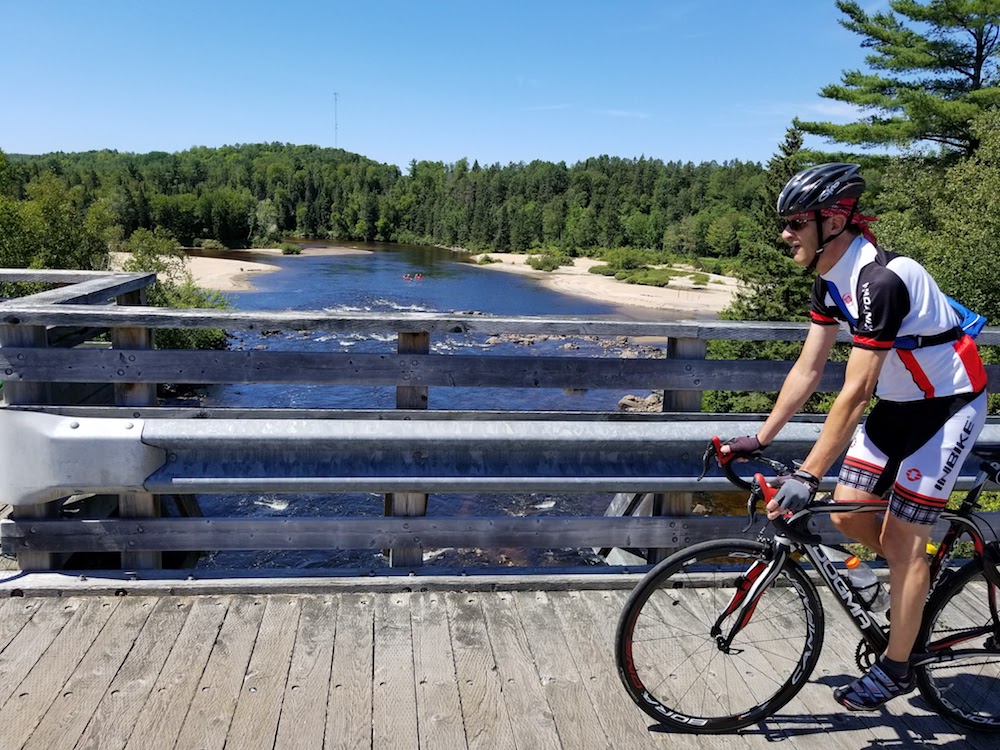
We left the km 200 sign and rolled briefly through the busy small city of Mont Laurier, then rounded a bend, and suddenly found ourselves on a car-less ribbon of asphalt. That is the beautiful thing about rail trails: the only people we saw from this point on were runners and walkers, or people rolling on bicycles, inline skates, roller skis, or the occasional motorized wheelchair.
We rolled through a beautiful forested landscape, isolated from towns, surrounded by woods and rivers. Every so often, we’d come across historical placards (all written in French) that revealed stories from a century ago. We stopped to admire a beautiful valley and learned from the sign that pink granite had been quarried from this area and sent to Barre, Vermont for finishing.
On we rolled through the endless corridor. As suddenly as we vanished into deep forest, we emerged into civilization: the village of Nominingue, where a festival was underway, the first of several that we encountered en route.
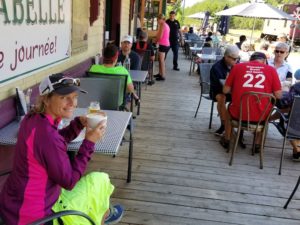
We took a welcome break from the saddle to stroll among craftspeople, artisans and musicians, and enjoyed a local beer. The Nominingue train station had been converted into an art gallery and café, the pleasant fate shared by many former stations along the rail trail.
A handful of cyclists strolled through the crowds in town, barely noticed. A few minutes away, we rolled into Chez Ignace, our stop for the night. This quiet inn is bounded by Le P’tit Train on one side and the large Lake Nominingue on the other. With a glass of wine, in hand, we watched the sunset from the dock.
Evenings in Quebec are an attraction unto themselves. Like Europeans, the Quebecois take food very seriously. Dinner overlooking the lake at Chez Ignace was memorable. It began with smoked salmon, followed by a refreshing gazpacho, a main course of a delicious grilled Quebec walleye, capped off by chocolate mousse. After a full day on the bike trail, we adapted well.
We were blessed with perfect weather as we set out on our second day, a 37-mile ride to Mont-Tremblant, the famous ski resort town. After a blood-pumping high-cadence spin through the countryside, we came to a bridge high over Rivière Rouge. Canoeists negotiated rapids far below, and bathers waded out to a sandbar to lounge in the sun.
We noticed that the scene around us was changing. Casual riders on hybrid bikes were typical on the northern section of the trail, but now serious road cyclists were rolling in from Mont Tremblant, including one orange-clad group of 10 riders who were doing a 400 km out-and-back ride of the entire P’tit Train in just 20 hours. As they hammered by us, I felt momentarily guilty about relaxing to enjoy the views.
Twenty minutes later, we found ourselves repairing a flat tire. We had just put the wheel back on Sue’s bike when Kim, a trail patroller, rolled up to offer assistance. “This is the most exciting thing that’s happened to me today,” she confessed as she handed us wipes to remove the dirt from our hands. She urged us to stop for lunch at the café at the Labelle train station 15 minutes ahead. The station, which has been converted into a railroad and ski museum and restaurant, was a busy crossroads where families and riders both serious and casual mingled. We were about to pull out a lunch of a baguette and cheese at a picnic table when we stopped to consider the lively café scene. Sue and I had the same thought: “When in Quebec, do like the Quebecois.” We sat at a table on the terrace, took in the sunshine and enjoyed an excellent Greek salad with quinoa and a local beer at our leisure.
Here at km 107, the trail changed from asphalt to fine crushed stone. The surface was fine for our road bikes with 700 x 28cm tires.
We soon found ourselves winding through a beautiful lakes region, and finally arrived at the town of Mont Tremblant, the halfway point of Le P’tit Train. The old railroad station had once again been colonized by a clutch of artists who milled about and happily discussed their paintings. A busy public beach lay 50 yards away.
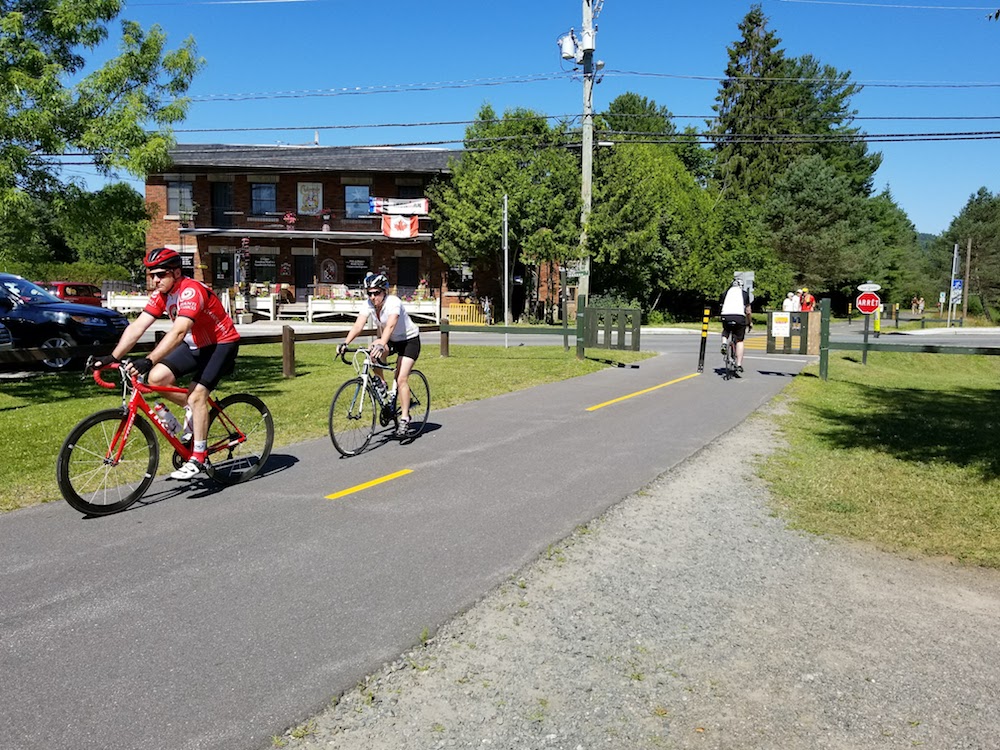
We couldn’t resist a detour to ride up to the ski area. We experienced some culture shock: from the relative solitude of the trail, we were startled to encounter a bustling and diverse Montreal neighborhood at play in the mountains. City and village were one here.
We spent the night at the comfortable and modern B&B, Le Voyageur, where 17-year owner Jean Claude told me that cyclists, once just a small part of his clientele, now comprise over half his business. He underscored his point by motioning to the newly paved section of trail in front of his inn that was teeming with runners and riders.
On our third day of riding, we stopped at Val David, a storied artist community along the former railroad line. We followed some music and pulled up stools at Le Baril Roulant, the local microbrewery, to sample some very tasty Quebec beer and listen to a jazz trio.
After staying the night at the rustic Auberge de la Gare, we enjoyed a dip in a cascading waterfall, followed by a high-speed final ride out to St. Jérôme. In the city plaza, a jazz pianist tickled the keys at an outdoor café, giving it the feel of an intimate European neighborhood. Sue raised a happy thumbs up as she passed through an orange arch that signified km 0.
Le P’tit Train du Nord had transported us. “Bonjour!” we instinctively greeted fellow riders who were just starting out.
Author David Goodman of Waterbury Center wrote about five of Vermont’s longest rail trails in the July, 2017 issue of Vermont Sports.
PLANNING A TRIP
Le P’tit Train du Nord rail trail stretches 200 kilometers from St. Jerome, just outside Montreal, northwest of Mont Laurier in the Laurentian mountains. The rail trail has also recently been extended another 32 km south of St. Jerome. The trail is part of Quebec’s 5,000 km Route Verte biking network (routeverte.com).
The Laurentian Tourism website laurentides.com is the best resource for planning a trip, with an interactive map with inns, parks and bus stops along the trail.
Cyclo-Gites can arrange the entire trip, with three nights’ lodging, dinners and breakfasts, starting at $235 (US dollars) per person, double occupancy. A one-way bus trip to the start is $47 and bag transport is $13.50 per bag. The company also offers shorter and longer trips (bbvoyageur.com/cyclo-gites.html).
You can also organize a trip on Le P’tit Train Du Nord on your own. Buses (with bike racks) depart from St. Jerome and make stops along
the route. They can also transport your bags
from stop to stop (autobuslepetittraindunord.com). There is also train service from Montreal to St. Jerome.
For those organizing their own trips, there are numerous inns and places to stay along Le P’tit Train du Nord, and many work together to provide three-night packages in the $300-per person range.
On the shores of Great Nominingue lake, Chez Ignace (ignace.qc.ca) has a hot tub, whirlpool baths and excellent dinners (a room for two with dinner and breakfast starts at US $140). Auberge le Lupin is a log cabin-style chalet near Lac Tremblant that TripAdvisor users named one of the 25 best B&Bs in Canada (lelupin.com.en). Built in St. Adele in 1891 when the railway was in full swing, Auberge de La Gare is a cozy clapboard inn which offers a room, breakfast and dinner starting at $81 per person, double occupancy (aubergedelagare.com). You can also try Auberge & Spa Nordique, right on the river with a pool lined by natural stones.
Several spur trails have been built near or just off Le P’tit Train du Nord, including the more rural “Park du Corridor Aerobique.” This 58-km route runs roughly east-west from Morin Heights to Amherst through a countryside of lakes, woods and farms. The trail is primarily crushed gravel and sand, geared more toward hybrids or mountain bikes, with singletrack offshoots. You can camp out or stay at one of several inns along the way. Check Corridoraerobique.ca/en.

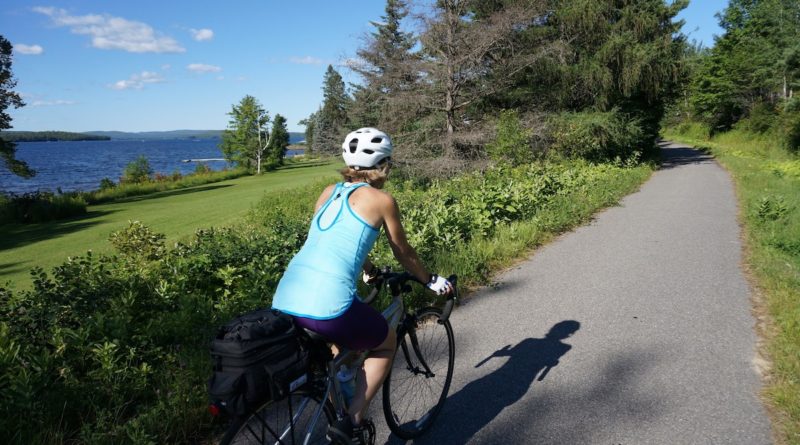
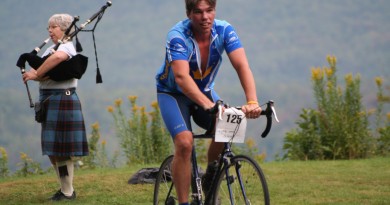
Pingback: Vermont Sports | Le p'tit train du nord